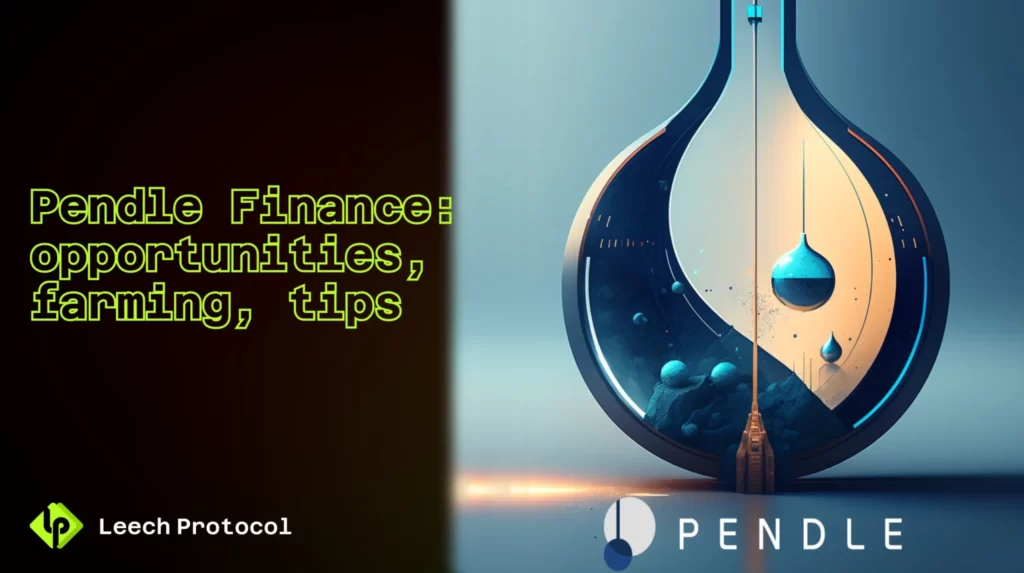Home | News & Insights Pendle Finance – DeFi’s Yield Trading Protocol Starting to explore yield farming strategies based on protocols, and today we’ll take a look at Pendle Finance. Table of content Pendle Finance is one of the most intriguing protocols in DeFi right now. Its launch somewhat preceded its time, and the DeFi market wasn’t ready for widespread adoption of this protocol just yet. However, Pendle Finance has benefited from many innovations in DeFi over the past year: the emergence of the LSDfi narrative, the introduction of numerous other efficient yield-bearing assets, and the thriving DeFi ecosystem on Arbitrum. So, what is Pendle? Pendle Finance is a protocol in the Interest Rates Markets category. What does Pendle do? It divides yield-bearing tokens into two parts: the base portion (Principal Token = PT) and the income portion (Yield Token = YT), creating a market (pool) for them. Naturally, each specific YT/PT pool will have a maturity date. At the maturity date, the YT token will be worth 0, while the PT token will be equal to 1 unit of the underlying asset. Let’s take a look at an example using stETH. YT (Yield Token) By holding 1 YT stETH 🪙 🟢 You will receive the yield generated by stETH. This yield can vary depending on the activity in the Ethereum network, changes in the Lido protocol, and changes in staking rewards in the Ethereum network. 🟢 Your YT stETH will have a value (and a market with sufficient liquidity, by the way). The value will be influenced by: It’s worth noting that the price of YT is significantly lower than that of the underlying asset. For example, currently, you can buy YT stETH with a maturity date of December 30, 2027, for ~$250, while stETH is priced at ~$1850. This means you can exchange 1 stETH for 7.4 YT stETH and earn the yield equivalent to that of 7.4 stETH. It’s a kind of yield leverage without liquidations. Degen Tips: By holding a position in the Yield Token (YT), you, in a sense, have a long position in the yield of the underlying asset, and you generate this yield more efficiently (with “leverage”). PT (Principal Token) By holding 1 PT stETH 🪙 🟢 You will not receive the yield generated by stETH. 🟢 Your PT stETH will have a value (and a market with sufficient liquidity as well). The value will be influenced by: In the example of the same pool with a maturity date of December 30, 2027, the price of PT stETH would already be around $1600. By purchasing PT, you essentially acquire the underlying asset at a discount. More precisely, you are fixing the current yield. Degen Tips: By holding a position in the Principal Token (PT), you, in a sense, have a long position in the underlying asset + fix the yield. This can also be partially viewed as a short position in terms of yield if you expect the yield to decrease. DeFi opportunities with Pendle Finance So, we’ve discussed how interest rates markets work on Pendle. Now, let’s explore some specific farming use cases with Pendle and around it. Let’s dive in and explore the Pendle APYs! Impermanent Loss-free farming through YT At Leech Protocol, we don’t consider Impermanent Loss (IL) as a significant risk (we can provide a detailed explanation upon request), but nevertheless, this feature is present in DeFi. Pendle helps to coexist with this feature. That’s exactly what Pendle, in collaboration with @CamelotDEX ⚔️, has done. In the screenshot, you can already see LP PENDLE-ETH (Camelot) and ARB-ETH (Camelot). Farming Tips: If you don’t want to deal with asset price volatility in the pool and are bullish on the yield of a specific LP, YT LP is suitable for you. Farming Tips: If you want to lock in the current yield of the LP you are farming, PT LP will be useful for you. Farming in Pendle pools Alright, so Pendle has liquid markets, but where does that liquidity come from? It comes from its own liquidity pools, which means we can also become liquidity providers in these pools. Pay close attention here. Let’s say you have ARB-ETH LP (Camelot) and want to earn additional yield on top of it. You can come to Pendle and use the zap-in strategy (similar to providing liquidity to a regular pool) in the LP pool. Now, your LP is split into YT LP and PT LP, and you: Moreover, the nature of YT/PT assets in Pendle pools allows you to not worry about Impermanent Loss. Pendle pools are one of the best places in DeFi for liquidity providers. 💡 Farming Tips: If you want to increase the yield of your yield-bearing asset, take a look at Pendle Pools. If you truly want to delve deep into DeFi strategies related to Pendle Finance, you won’t find better threads than those from Vu Gaba Vineb. Farming based on Pendle The ve-tokenomics of Pendle Finance have not gone unnoticed, and the Pendle Wars have even ignited. To learn more about what is currently happening, check out an excellent thread by Small Cap Scientist. In any case, this has provided a boost for the development of a range of projects built on Pendle. The rewards earned in $PENDLE can already be directed towards yield boosters such as Equilibria or Penpie. Additionally, you can provide liquidity in Pendle Pools through similar projects, thereby earning yet another type of token rewards. Just take a look at the yield structure! In conclusion, we want to emphasize that Pendle may not be the most intuitive protocol, but it is highly versatile. It’s worth understanding it, if only because interest rate markets have the potential to become one of the largest markets in DeFi in the medium to long term. What should you do next? *Try our automated cross-chain farming app (soon) * Follow our Twitter for more DeFi and YieldFarming tips * Join our Telegram for Daily Farming discussion * Join our Discord to claim your roles and become early community member Share: Twitter Facebook Telegram



